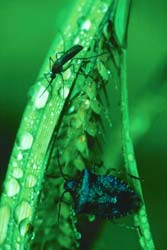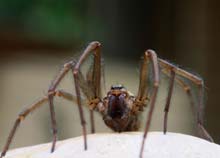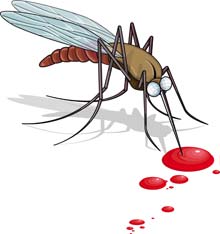How to Safely Repel Bugs, Ticks, Lice and Mosquitoes ...
Find Out Now to Avoid the Coming Infestation Explosion!
by www.SixWise.com
You’ve heard the phrase “April showers bring May flowers” … well spring rains combined with warm temperatures are also a prerequisite for bringing all kinds of creepy crawly bugs out of their hiding places.
|

A heavy season of snow and rain has resulted in prime breeding ground for buzzing, biting and creepy crawlies of all kinds ... from mosquitoes to spiders and everything in between!
|
Due to the early warming trend and heavy spring rains that occurred across much of the United States, many areas are seeing an explosion of insects coming seemingly out of nowhere. This explains why you, too, have likely noticed more insects, and larger insects, in your home and yard … even earlier than in seasons past.
According to experts, such as Dr. Michael Wall, curator of entomology and director of the Biodiversity Research Center of the Californias at the San Diego Natural History Museum, there will likely be a bumper crop of bugs this year.
He said in a radio interview with Maureen Cavanaugh of KPBS:
“ … The distribution of rains and the warm weather … all that’s really good for the plants and – or as entomologists refer to them, it’s good for the bug food. So whatever’s good for the bug food is going to end up being good for the insects so it really is going to be, and already is, a bumper crop.”
What Kinds of Pests Can You Expect in Your Area?
Winter and spring weather can greatly impact the spring and summer’s pest population, so just how many bugs will emerge in your area depends in part on your region’s climate and weather patterns.
“When conditions are warm and wet, many pests begin to swarm in search of food, shelter and mates,” Dr. Bob Davis, entomologist and a scientist at chemical company BASF, told BusinessWire.com. “Unfortunately, this search brings many of these pests inside, where they can create a nuisance and destroy property.”
Davis gave a breakdown of what types of bugs you can expect in your neighborhood this season. As Business Wire reported:
-
The South: Long hot and humid summers and mild winters make for abundant pests, including many species of ants.
-
The West: A colder-than-normal winter and heavy snow and rain is leading to heavy pest infestation, including spiders, scorpions, beetles and termites.
-
The Midwest: Flooding and excess rains are leading to an influx of pests that love damp conditions. These include silverfish, spiders and termites. Carpenter ants and other ant species are also common.
-
The Northeast: Record snowfalls and rains, along with warm temperatures, are leading to infestations of termites and black carpenter ants. Although not weather related, bed bugs are also becoming increasingly common on the East Coast.
|

After the initial surge of plant-eating bugs emerge, predatory insects like spiders will begin to come out in full force.
|
Which Bugs are Dangerous … and Which are Just a Nuisance?
Most people don’t adore bugs of any kind, but the truth is that many bugs are completely harmless and actually beneficial for your local ecosystem. There are, however, some insects that you should steer clear of because they can transmit disease or deadly stings and toxins to humans.
Risky pests you should know about include:
- Mosquitoes: Mosquitoes' risk comes from their ability to transmit disease. In this part of the world, mosquitoes can carry West Nile Virus, and about one in 150 people bitten over one million people in the US will develop a serious case.
In severe cases, symptoms include headache, high fever, stiff neck, disorientation, muscle weakness, tremors and paralysis, so if you notice these symptoms about two to 15 days after being bit by a mosquito, see a health care practitioner right away.
-
Ticks: Ticks bite animals, including humans, to feed on their blood, and in doing so can transmit diseases including Rocky Mountain spotted fever, Lyme disease (a potentially serious bacterial infection that causes a rash and flu-like symptoms including fatigue, headache, stiffness or pain in neck, muscles and joints, fever and swollen glands), babesiosis (Texas fever), ehrlichiosis, tularemia, Colorado tick fever and Powassan (a form of encephalitis).
-
Houseflies: Houseflies "sponge" up food using a spongy part of their mouth, and when they land on your food they can leave behind typhus, dysentery, tuberculosis, poliomyelitis, cholera, pinworms, hookworms and some tapeworms.
-
Fire Ants: Fire ant stings are painful and also contain toxins that can be dangerous in large amounts, or to small children. Further, fire ants are not only aggressive, but they can also use pheromones to communicate and attack in unison.
-
Brown Recluse Spider: Brown recluse spider venom is toxic but the bite may go unnoticed, as it feels much like a mosquito bite. However, the bite will become surrounded by a spreading rash that can eat away flesh, cause scarring and even the loss of a limb.
-
Bees, Wasps and Hornets: Although bees are not aggressive and typically won't sting unless disturbed (such as if you step on one while walking barefoot), yellow jackets, wasps and hornets can be aggressive.
Most stings result in local swelling, pain, itching and redness, and in uncommon circumstances infection can occur. In those who are allergic to the venom, however, a sting can be life threatening.
Before Going on Vacation, Know the Potential Insects in the Area
Example: Costa Rica is known for its truly bad bug bites from mosquitoes that can implant bot fly larva under your skin.
Best and Worst Insect Repellants
While there are seemingly many insect repellant options on the market, few are actually safe and effective. Many repellants, such as those that contain DEET, can be more hazardous to your health and your family’s health than the bug bite itself.
Take a minute to truly know and learn what is safe and effective.
A Warning About DEET Insect Repellants
Your first instinct to get rid of pests may be to purchase a strong insecticide to spray around your yard, home or on your body. However, pesticides can be extremely hazardous, as can DEET, the active ingredient in most insect repellants.
In fact, studies conducted at Duke University have found that using DEET frequently or for extended periods may damage your brain cells, resulting in:
-
Memory loss
-
Headache
-
Weakness and fatigue
-
Muscle and joint pain
-
Tremors
-
Shortness of breath
While the EPA maintains that the chemical is safe when used correctly, studies have shown that when used in high amounts, or for long periods of time, DEET is far from safe.
According to studies by Mohamed Abou-Dania, a professor at Duke University, while lab rats had no reaction to DEET when it was used for 30 days, after 60 days their brain cells started to die. This chemical has also been shown to cause nervous-system damage, including:
It may take months or years for such symptoms to develop, making it difficult to establish DEET as the cause, Abou-Donia said.
"The take home message is to be safe and cautious when using insecticides," Abou-Donia told DukeHealth.org. "Never use insect repellents on infants, and be wary of using them on children in general. Never combine insecticides with each other or use them with other medications. Even so simple a drug as an antihistamine could interact with DEET to cause toxic side effects. Don't spray your yard for bugs and then take medications. Until we have more data on potential interactions in humans, safe is better than sorry."
Adding to the problem is the fact that DEET does not degrade quickly, nor does it breakdown much as it passes through sewage or drinking-water treatment plants.
Scientists are worried that DEET may collect in the sediment of streams and prove toxic to birds, fish and other wildlife.
|

Don’t let the name fool you ... Lice B Gone works as an excellent repellent of mosquitoes, flies, sweat bees, gnats and more. Simply spray it on exposed skin or mist your home or yard, and it is a very effective, natural repellent for about three hours!
|
A Safe Pesticide-Free Solution to Pest Infestations
You and your family can safely repel all kinds of insects naturally, with no health risk and no toxic chemicals, by using all-natural Lice B Gone. Please don’t let the name fool you … it’s effective against much more than just head lice and can control in-home pests including ants, bees, flies, mosquitoes, gnats and more.
This is a gem of a product that is little known and not heavily marketed because it is manufactured by a small natural business in southern Illinois. The scientific developer was holistically focused on the health and well-being of our children first and foremost, so he developed both Lice B Gone and Flea ‘n Tick B Gone, which safely removes fleas and ticks from pets (and also doubles as a safe insect repellant for other pests, too!).
Lice B Gone is an ideal alternative to DEET-containing repellants because it's an enzyme-based formula made naturally from plant resources.
It is even safe enough to spray directly onto your skin, plus, you can use it as an entirely non-toxic insect repellant for your backyard, home or picnic area. Just mist the area or your skin and you're tick- and bug-free for about three hours!
Remember, Lice B Gone is a proprietary blend of water and non-bacterial enzymes (amylase, cellulase, lipase, protease) from plant origin. It is biodegradable and ecologically harmless to aquatic, plant and animal life … including you and your family!
So while enjoying the spring and summer weather, don’t put your health at risk by spraying toxic DEET-based insecticides on your skin, or using chemical pesticides around your home. Lice B Gone is a safe and highly effective alternative that will become a favorite staple in your home!
Recommended Reading
Bugs that Bite: Interesting Facts & Necessary Precautions on the Insects That Crave You
How to Most Effectively Keep Flies, Wasps, Gnats and Other Pests Away from Your Picnic This Summer
Sources
KPBS.org April 8, 2010
BusinessWire.com March 23, 2010
DukeHealth.org January 10, 2007
DukeHealth.org May 1, 2002
U.S. EPA, DEET